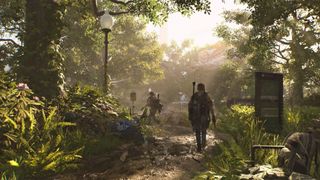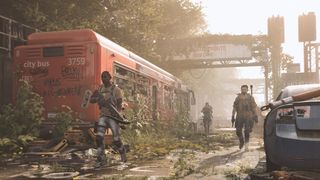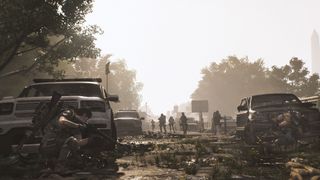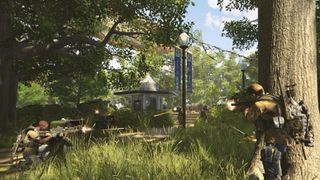The Division 2 is an iteration, not a revolution – and that's a good thing
The Division 2 heavily draws on previous entries in the series but also features strong foundations for the future.

Like many of Ubisoft's top titles, Tom Clancy's The Division overcame troubled beginnings and is now among the top online RPGs on modern systems. Building on its best features, regular updates delivered a pool of end-game content, positioning it among the greats of the Tom Clancy's legacy. And now with the upcoming successor, Ubisoft looks to take what it learned and deliver a clean slate tailored to player demands.
Tom Clancy's The Division 2 is over half a year away, and we're still gaining an understanding of what the title hopes to deliver. As with many sequels, the game will be familiar, leveraging recognizable core systems shrouded in new content. It creates hurdles, making it harder for The Division 2 to stand out, but the changes it brings provide only more reasons to immerse yourself in its world.
After spending some time with one of The Division 2's early missions at Gamescom 2018, Ubisoft seems to have established a promising start, built on an already strong foundation.
The Division 2's familiar foundations

For returning fans of The Division, its much-anticipated sequel will be familiar not only in core mechanics but also broader content offerings. The third-person online RPG retains the same focus, pushing cover-based encounters and cooperative teamplay. Loadouts and class roles encourage players to develop synergies and additions like high-level "specializations" promise to further deepen this process. Systems like this drive player progression, most importantly paired with that hope for the next drop of color-coded loot.
Comparable combat also returns for The Division 2, with the tight gunplay and tiered enemy design expected from the series. Controversial bullet-sponge enemies return, but from our time with the demo, there was a sense of heightened tactile feedback when you land your shots. Boss encounters are a prime example, where tactics shift to finding armor weak points, rather than blindly unloading shots into lengthy health bars. These are minor changes to how combat is approached, that while fresh and rewarding, don't abandon The Division's core identity.
Ubisoft must provide quantity and variety of content, while ensuring the game distinguishes itself.
From a gameplay perspective, The Division 2 isn't a huge departure from the original, seemingly headed for similar mission structures, combat philosophies, and player progression. The title has the benefit of shipping without the first game's launch flaws, making for more appealing gameplay all around. However, Ubisoft must provide quantity and variety of content, while ensuring the game distinguishes itself from its predecessor.
Making the move to Washington D.C.

One of The Division's key shortcomings was a lack of intertwined narrative; a common flaw of many shared-world RPGs. While other mechanics aimed to keep players invested in its universe, the end result was a world that, despite its potential, failed to provide context to gameplay. Although The Division 2 seemingly won't set the bar for world-building, it's doubling down on creating a living world to explore.
Get the Windows Central Newsletter
All the latest news, reviews, and guides for Windows and Xbox diehards.
During our time with Ubisoft at Gamescom, the team expressed the value of its world, and how it can drive deeper lore. It's a belief embraced throughout what we've seen so far, adding context and reference points to in-game events. Promising variety and identity absent in post-outbreak New York City, the publisher is committing to a near "1:1" recreation of Washington D.C.

Ubisoft claims the capital stood out for its variety, chosen over other U.S. cities like Seattle and New Orleans. This variety means six distinct regions across the map, each promising to bear distinct atmospheres and gameplay opportunities. Set seven months after The Division, the new locale is paired with a hot summery climate, further distancing itself from NYC's frozen city blocks.
A near '1:1' recreation of Washington D.C.
This makes for what's shaping up to be an accurate portrayal of the city, rebuilt within Ubisoft's in-house Snowdrop engine. Leveraging GPS and architectural data makes for faithful replicas of real locations, even promising consideration of real trees, benches, and street signs. And no matter your familiarity with the city, seeing the U.S. Capitol Building in disrepair or the crashed Air Force One wreckage never fails to impress.
Our hopes for The Division 2

The Division 2 is looking like a worthy successor, but questions still lie ahead for launch. Ubisoft is lining up a variety of promising end-game content like eight-player raids, and execution will be crucial to its reception. From our hands-on time, and details shared so far, it appears fans of The Division will find a lot to love once the game hits store shelves next year. However, if the original offering's gripes may transfer to the next title. With no major new gameplay since E3 2018 in June, we're eagerly awaiting what comes next.
The Division 2 is currently available for preorder starting at $59.99, ahead of a scheduled March 15, 2019 release for Xbox One, PlayStation 4, and Windows PCs.
Matt Brown was formerly a Windows Central's Senior Editor, Xbox & PC, at Future. Following over seven years of professional consumer technology and gaming coverage, he’s focused on the world of Microsoft's gaming efforts. You can follow him on Twitter @mattjbrown.

